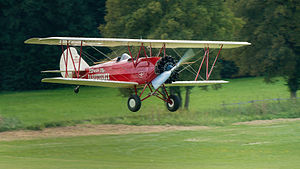Travel Air 4000
| 2000, 3000, 4000, CW-14, Sportsman, Osprey | |
|---|---|
 |
|
| Travel Air 4000, at landing | |
| Role | biplane aircraft |
| Manufacturer | Travel Air, Curtiss-Wright |
| Designer | Lloyd Stearman |
| First flight | 13 March 1925 |
| Introduction | 1925 |
| Primary user | private owners, aerial sightseeing businesses |
| Produced | 1925–1930 |
| Number built | approx 1,300 |
The Travel Air 2000/3000/4000 (originally, the Model A, Model B and Model BH and later marketed as a Curtiss-Wright product under the names CW-14, Speedwing, Sportsman and Osprey), were open-cockpit biplane aircraft produced in the United States in the late 1920s by the Travel Air Manufacturing Company. During the period from 1924-1929, Travel Air produced more aircraft than any other American manufacturer, including over 1,000 biplanes (some estimates range from 1,200 to nearly 2,000).
The original Travel Air Model A was engineered chiefly by Lloyd Stearman—with input from Travel Air co-founders Walter Beech, Clyde Cessna, and Bill Snook—largely as a metal-framed improvement of his immediately previous design of the wood-framed, metal-cowled Swallow New Swallow biplane, with elements of the best fighter aircraft of World War I, the metal-framed German Fokker D-VII. Most subsequent Travel Air biplanes were derived, directly or indirectly, from the original Model A.
The types shared a common structure of a conventional single-bay biplane with staggered wings braced by N-struts. The fuselage was of fabric-covered steel tube and included two open cockpits in tandem, the forward of which could carry two passengers side-by-side.
In common with the Fokker D-VII, the rudder and ailerons of first Travel Air biplanes had an overhanging "horn" to partially aerodynamically counterbalance the aerodynamic resistance of the controls when deflected, to provide a lighter control feel, and a more responsive aircraft. This gave Travel Airs their distinctive "elephant ear" vertical tails, and the similarly counterbalanced ailerons were also referred to as "elephant ear" ailerons—leading to the airplane's popular nicknames "Old Elephant Ears" and "Wichita Fokker." Some subsequent models were offered without the counterbalance, providing a cleaner, more conventional appearance and less drag. Elevator forces were trimmed out by use of an inflight-adjustable horizontal stabilizer.
...
Wikipedia
